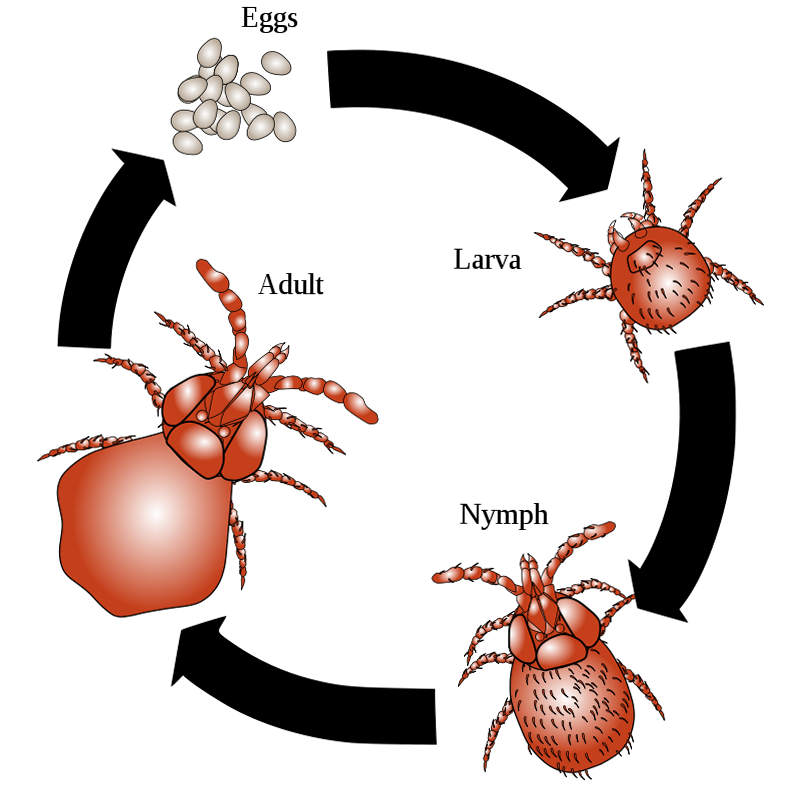- Home
- Garden Wildlife
- Arthropods
- Arachnids
- Mites Introduction
Harvest mite life-cycle showing 6-legged first instar larva, and an electron micrograph of a four-legged gall mite.
Most mites go unnoticed. There are, however, some that may be spotted in gardens. The gall mites and sap-sucking mites such as the spider mites, are covered in greater detail in their own pages on this site.
Velvet mites,
These are also known as trombidid mites, and are red mites, 3-4mm long when adult, their bodies are covered with short hairs, which gives them a velvety appearance. They are broadest at the shoulders with a distinct reduction in width about half way down the body. Adult velvet mites overwinter in the soil and may be seen crawling over soil in the spring. Velvet mite nymphs are parasites that attach themselves to various insects, spiders or harvestmen, where they suck fluids from the host animal’s body or legs. Adult velvet mites are predators of small insects.
Common garden species include Eutrombidium rostratus, Trombidium holosericeum and Allothrombium fuliginosum, which feeds mostly on aphids.
Predatory mite Phytoseiulus persimilis used to control red spider mite
Oribatid mites, also known as beetle mites, are mostly 1-2mm in length when fully grown. They have robust and hard body shells. Most live in the soil and leaf litter, where they feed on dead foliage and other organic matter. The species most likely to be seen by gardeners is Humerobates rostrolamellatus. This lives on the bark of many trees and shrubs or on fences, where the mites feed on algae and lichen. Oribatid mites have very low metabolic rates, and during the day, the black or reddish brown mites tend to remain stationary in clusters. They are often mistaken for eggs until they start moving.
Oribatid or beetle mite Right: Cluster of Oribatid mites, Humerobates rostrolamellatus
Harvest mites are in the family Trombiculidae, and in the USA they are called "chiggers". The key stage from the human perspective is the minute six-legged larva, usually less than 0.5mm in size, which feeds on the skin of birds and mammals, including people. They inject digestive enzymes into the skin that cause inflammation, irritation and itching. The 8-legged later nymphal stages and the adults leave their host and live on the ground, eating plant material.
They are active from mid-summer to early autumn, particularly in places where there is long grass or other rank vegetation. The mites climb up the plants and attach themselves to animals as they move through the vegetation. Once they have arrived on humans, harvest mites tend to move around until their movement is restricted by tight clothing or watch straps. As a consequence, bite marks are often concentrated around the waist, wrists and ankles.commonest harvest mite in Britain and Ireland is Neotrombicula autumnalis.
Harvest mites infesting a pipistrelle bat Typical "bites" caused by harvest mites
Varroa
Varroa destructor is a mite that originates from south east Asia where it is a parasite of an Asian honeybee, Apis cerana. It has transferred to the European honeybee, Apis mellifera, and is now present throughout most of the world, including Britain and Ireland. The European honeybee is much less able to tolerate the mite than its original host bee species. Varroa mites have a crab-like appearance, being wider than their 1mm length. The mites suck fluids from the bodies of larval, pupal and adult honeybees. This weakens the bees and spreads virus diseases within the bee colony. Beekeepers can take steps to control Varroa and so keep their bees in a healthy condition. Recent studies have shown sublimated oxalic acid is effective1. Unmanaged hives and feral honey bee colonies in hollow trees often die out after two or three years due to the impact of the mites and virus diseases.
Mites
Mites are mostly tiny animals, microscopic or barely visible to the naked eye. They form the sub-class Acari of the order Arachnida. Apart from a few species of economic importance, they are a poorly studied group of animals and it is very likely that there are many species that will be added to the list of those found in Britain and Ireland.
Mites are related to spiders, harvestmen and pseudoscorpions. Most species have four pairs of legs when adult but newly hatched mite nymphs have three pairs (a classic trick to confuse student zoologists). Eriophyid mites, also known as gall mites, have only two pairs of legs. The head,thorax and abdomen are fused into a single unit.
![Gall mite Aceria Photo by Eric Erbe; digital colorization by Chris Pooley (USDA, ARS, EMU).[2] - This image was released by the Agricultural Research Service, the research agency of the United States Department of Agriculture, with the ID K9077-23 (next)., Public Domain, https://commons.wikimedia.org/w/index.php?curid=515635](images/Rust_Mite,_Aceria_anthocoptes.jpg)
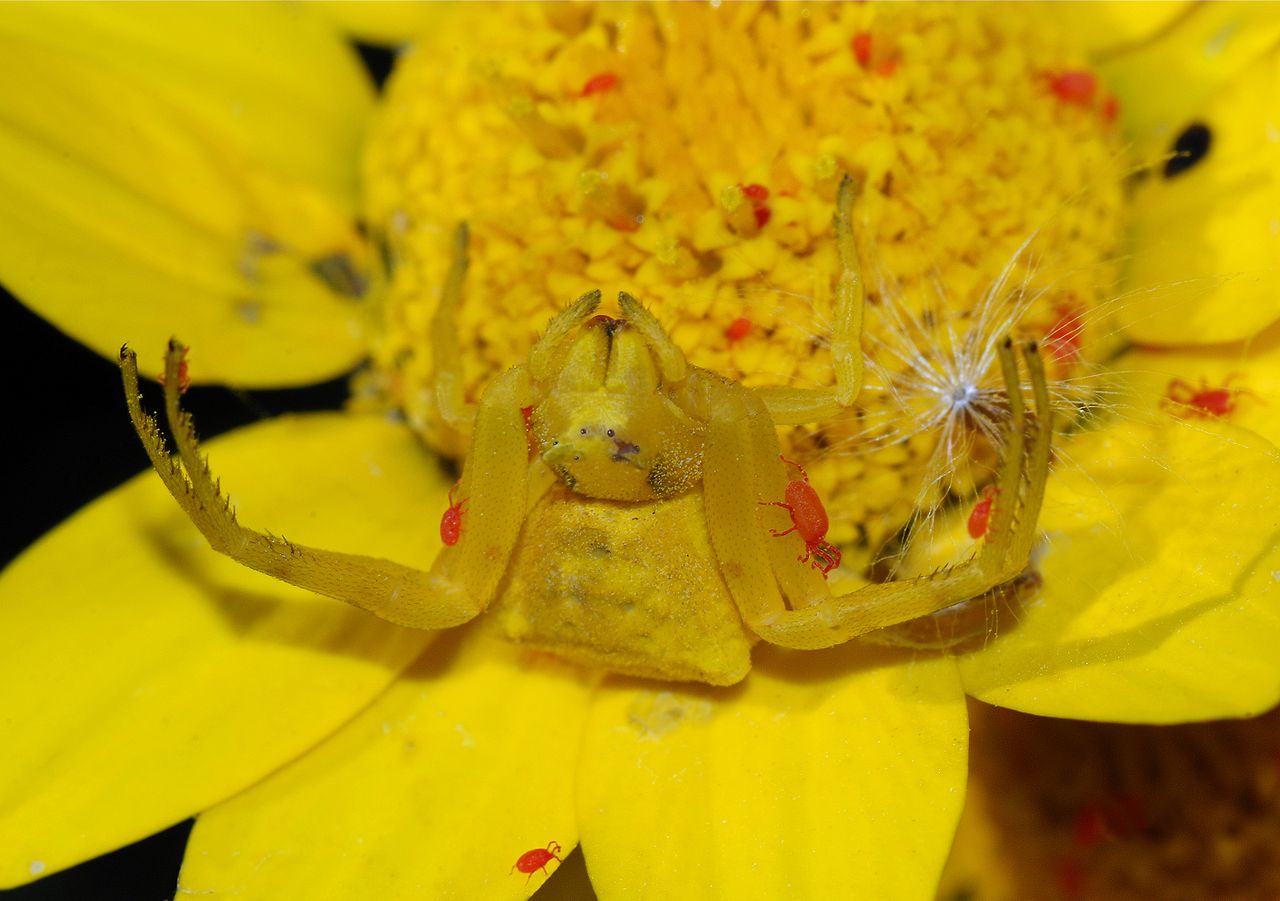
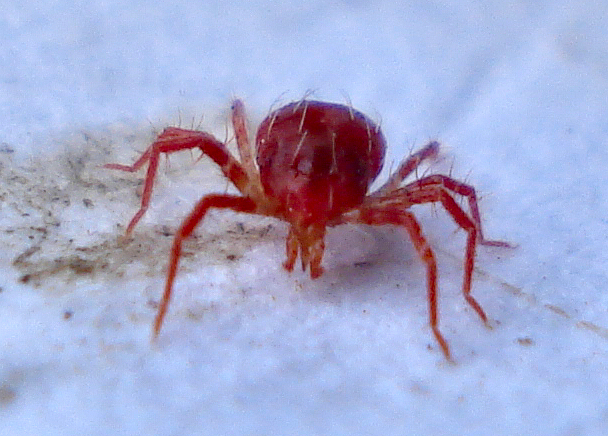
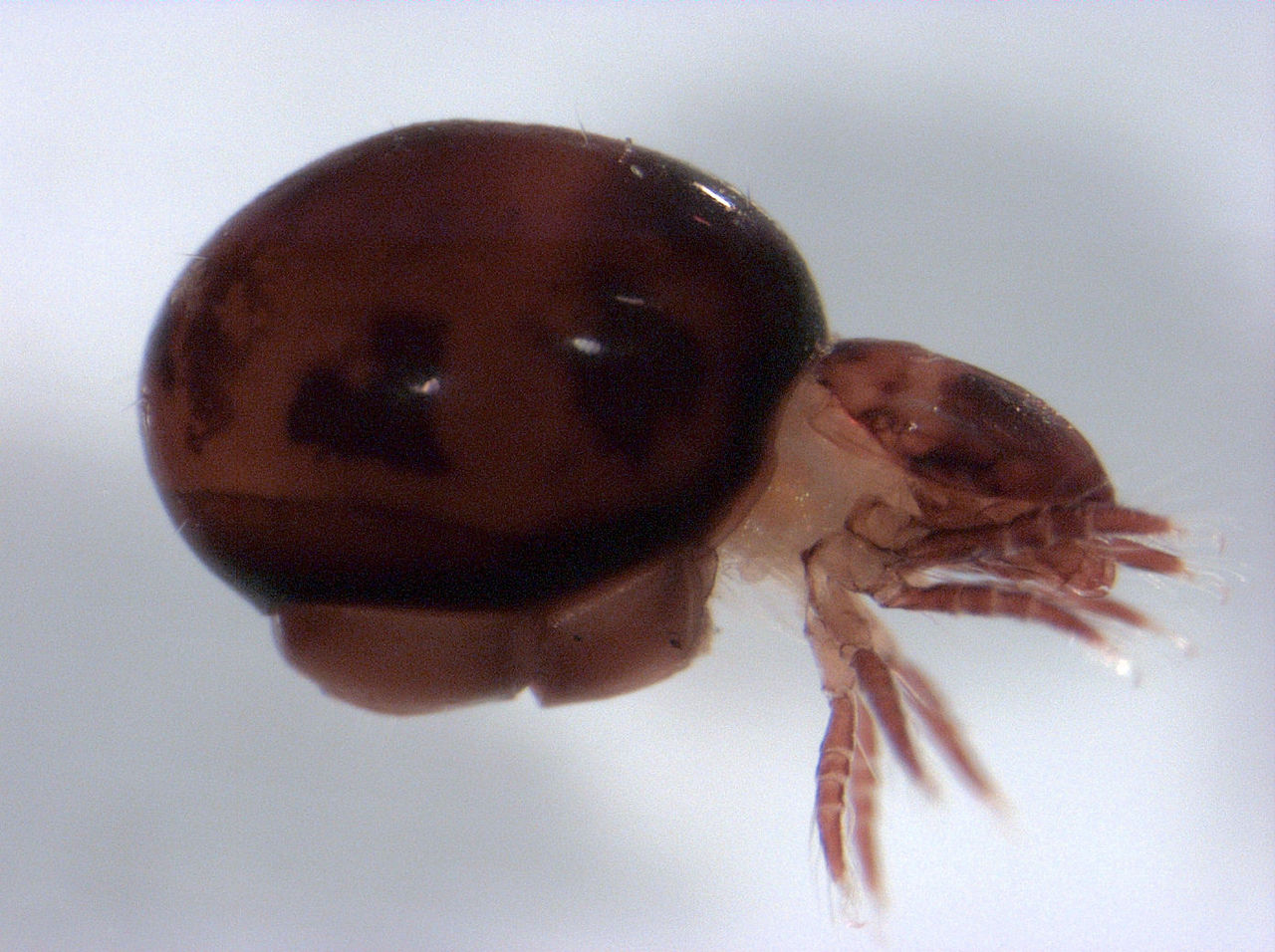
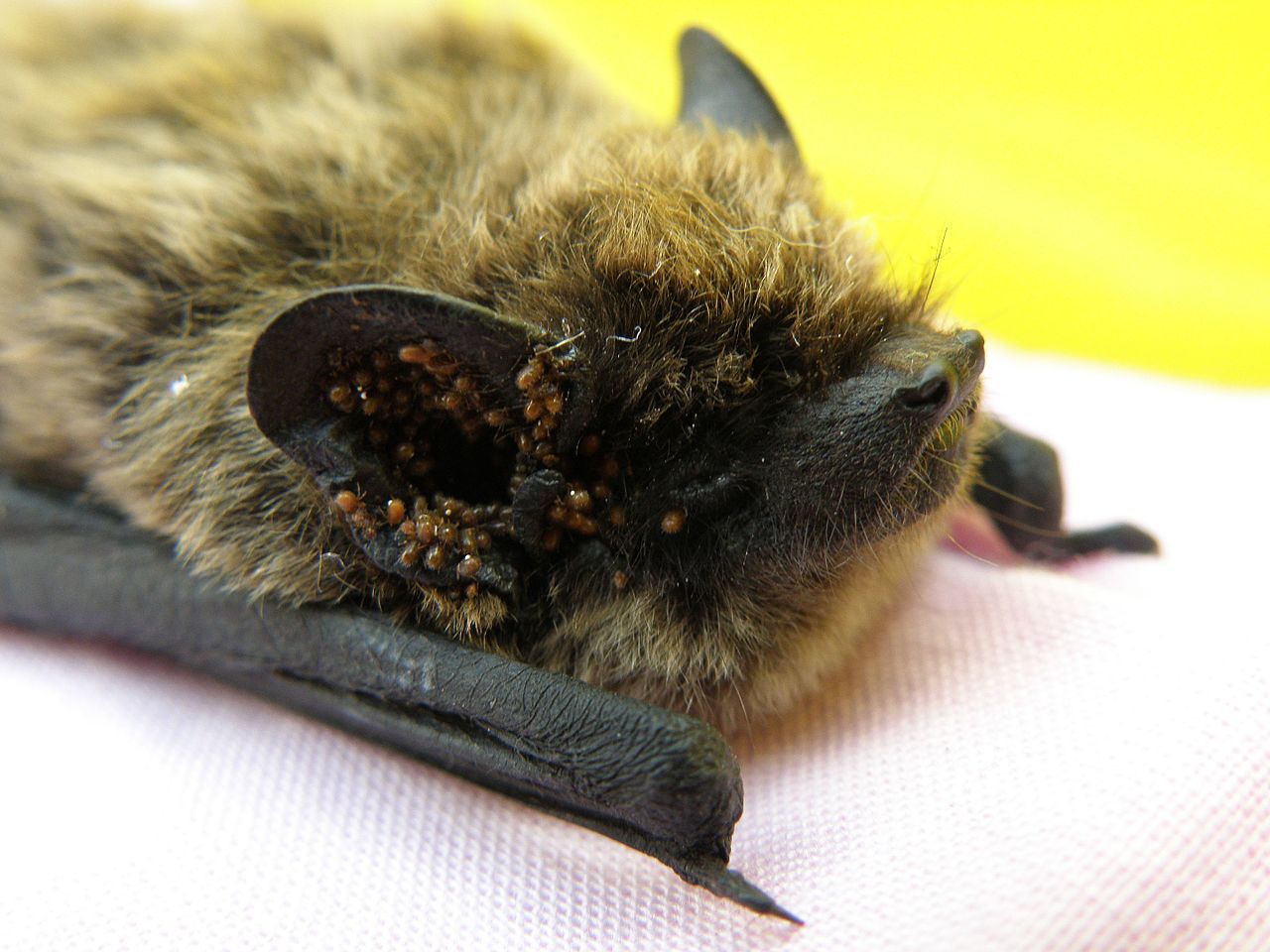
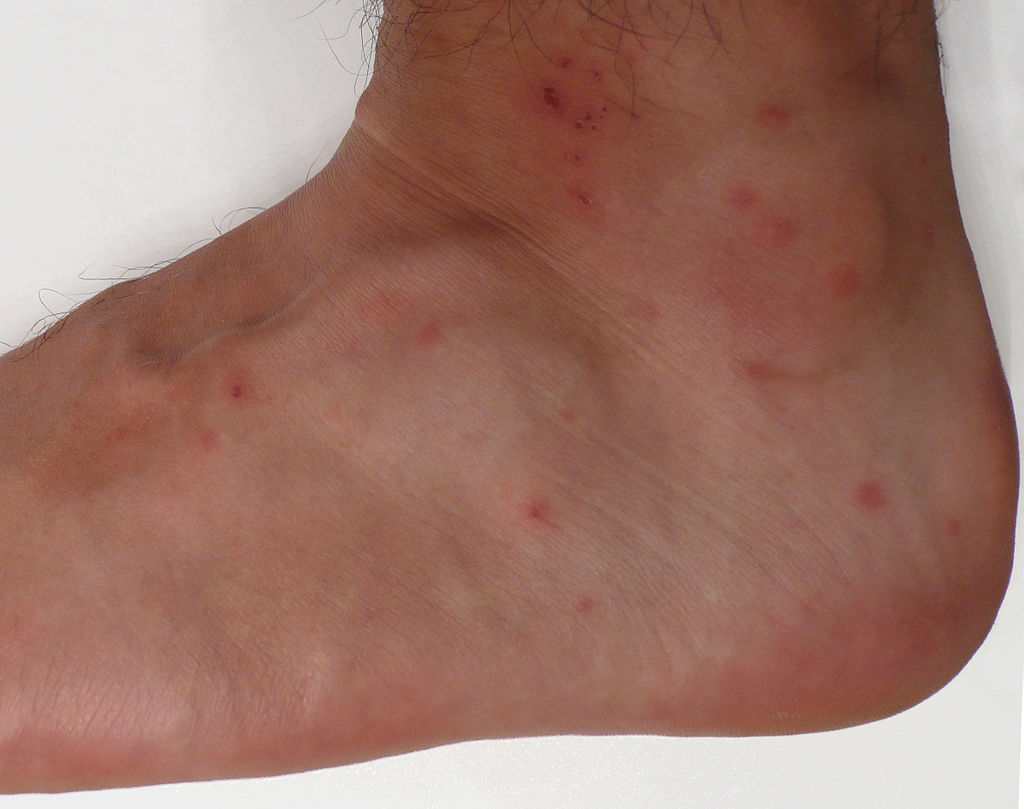
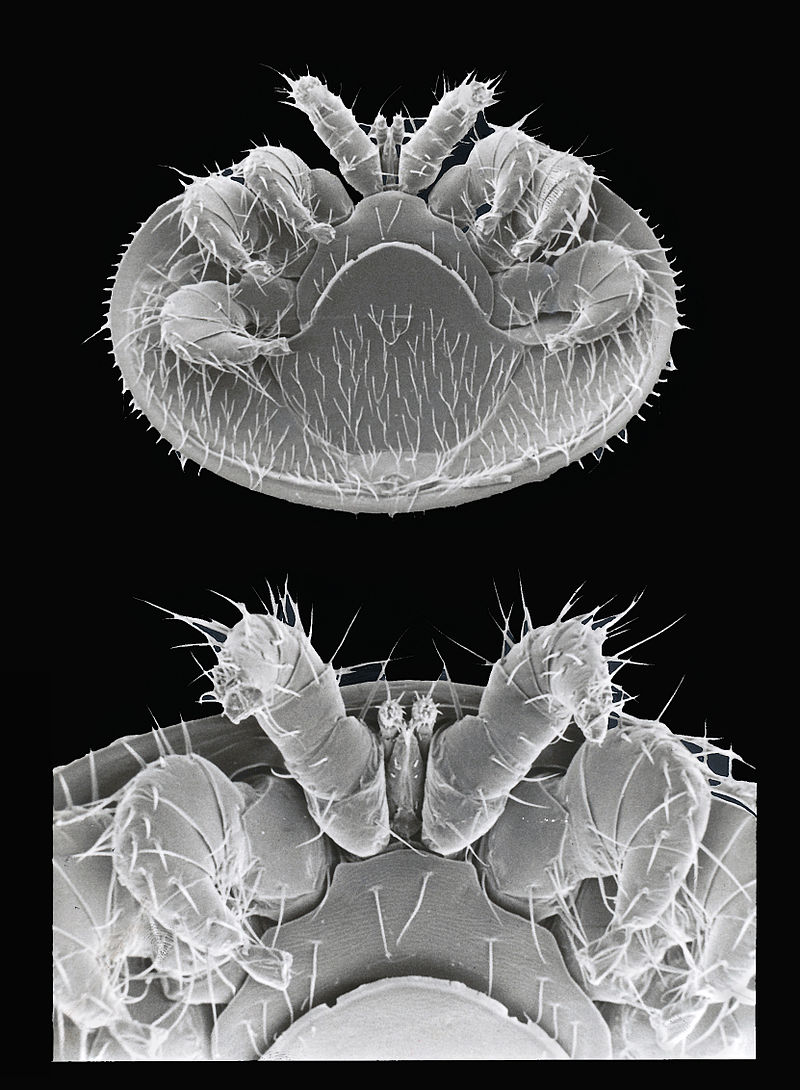
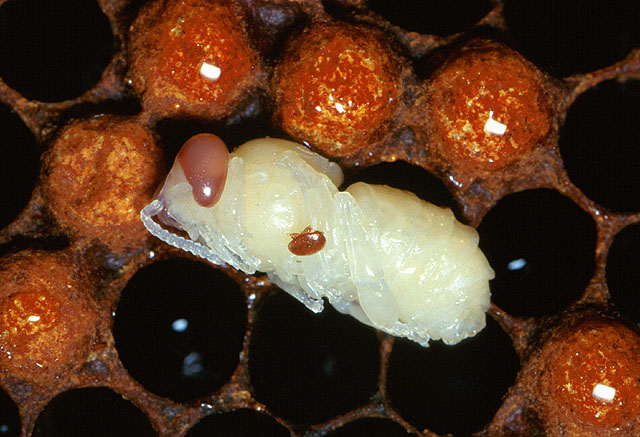
Left: Scanning electron microscope image of Varroa destructor. Right: Varroa mite on honeybee pupa
Ticks
Most ticks are in the family Ixodidae. Ticks are blood sucking mites that are active from late spring to autumn. The most common genus is Ixodes with five species in Britain and Ireland, including the sheep tick, Ixodes ricinus, also called the castor bean tick or the deer tick, which is the one most likely to bite people. These ticks will take blood from a wide range of mammals (including cats, dogs and hedgehogs) and birds. When fully grown and engorged with blood, a female sheep tick can be about 12mm long and 8mm wide. Tick nymphs climb up plant stems and climb onto passing host animals, including humans. They may remain on the host animal for several days with their mouthparts embedded in the skin. When the blood meal has been taken, the tick nymph drops to the ground where it remains while the meal is digested. The nymph then sheds its outer skin and grows larger, repeating the feeding and digesting cycle until the tick becomes adult.
Ticks are usually uncommon in gardens unless brought in on your domestic pets, and are more likely to be picked up during countryside walks. They can transmit the bacterium Borrelia burgdorferi that causes Lyme disease, which can develop into serious illness if not diagnosed and treated during the early stages of infection.
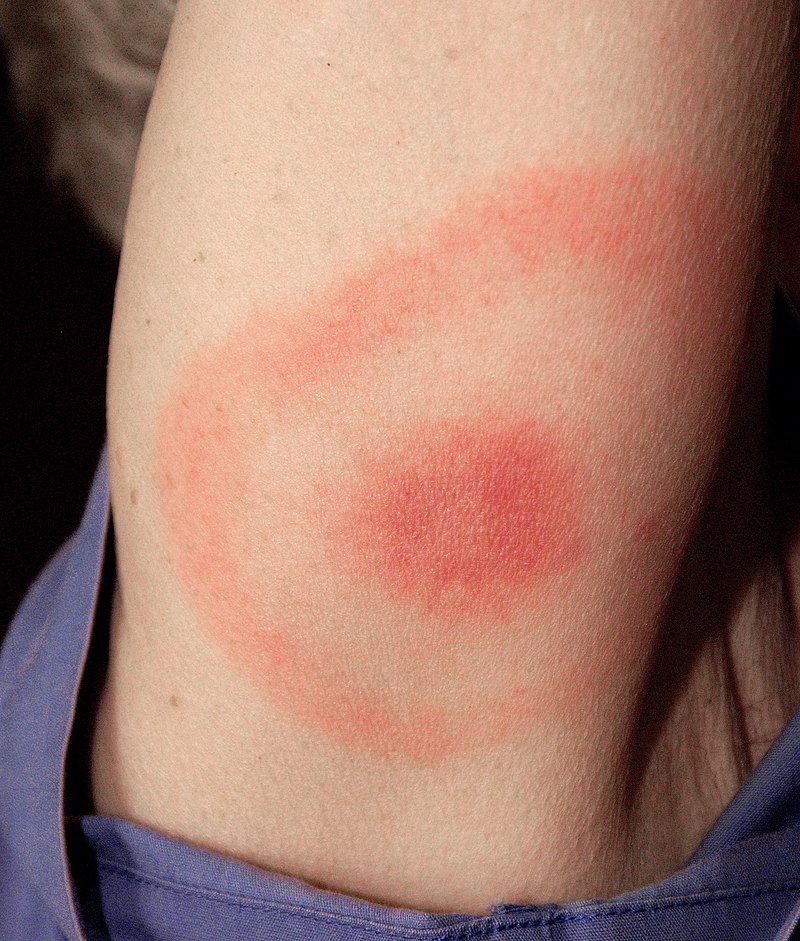
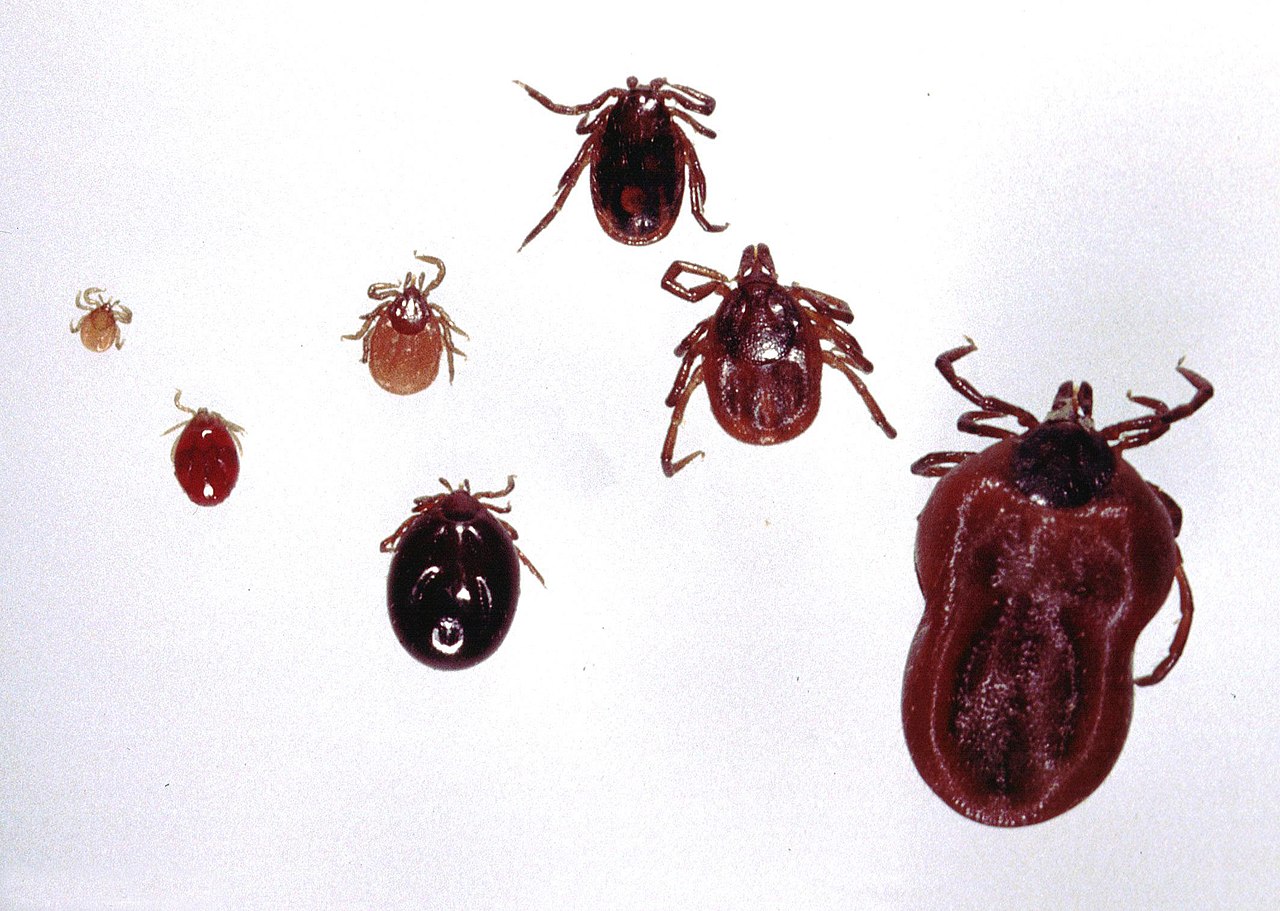
Left: Life stages of Ixodes ricinus. At extreme left the 6-legged larva, later instars, at top the male and female, and lower right a partially engorged adult. Right: the characteristic "bulls-eye" rash of Lyme disease.
Water mites
The Hydracarina or water mites are an abundant but poorly studied group of aquatic mites, somewhat related to the velvet mites. There are 6,000 species described globally, and about 300 in Britain and Ireland, and they are notoriously difficult to identify to species level. They have long legs (by mite standards) with hairs that make them effective for swimming. The six-legged larval stage is parasitic on adult aquatic insects, especially mosquitos, beetles, water bugs and dragonflies, which help them disperse. The later nymphal stages and adults are predators on small pond invertebrates and their eggs. While most are small, some are large as mites go, with Hydrachna geografica reaching 7mm. Many are brightly coloured red or green.
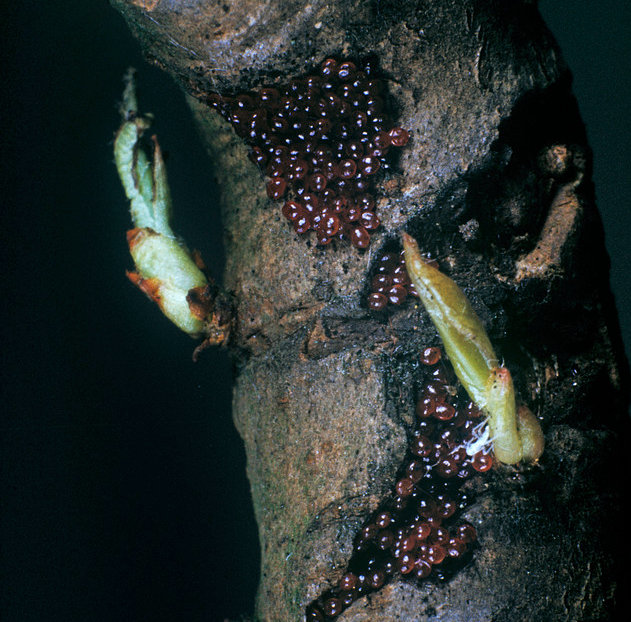
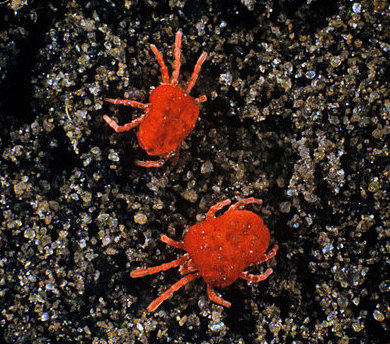
.jpg)
_with_Water_Mites_(Hydracarina)_(16368303717).jpg)
Water mites Eylais species left, and a dragonfly laden with mites,
Reference
1. Integrated control of Varroa mites http://www.sussex.ac.uk/lasi/sussexplan/varroamites
Websites
Natural History Museum's developing webpage on biodiversity of British mites
Web page on Varroa on the National Bee Unit website
Bristol University key to British tick genera
ESCCAP web page on ticks of domestic animals
Web page on Lyme disease on NHS website
Page text drafted by Andrew Halstead, reviewed by Andrew Salisbury, compiled by Steve Head
Mites
Mites are mostly tiny animals, microscopic or barely visible to the naked eye. They form the sub-class Acari of the order Arachnida. Apart from a few species of economic importance, they are a poorly studied group of animals and it is very likely that there are many species that will be added to the list of those found in Britain and Ireland.
Mites are related to spiders, harvestmen and pseudoscorpions. Most species have four pairs of legs when adult but newly hatched mite nymphs have three pairs (a classic trick to confuse student zoologists). Eriophyid mites, also known as gall mites, have only two pairs of legs. The head,thorax and abdomen are fused into a single unit.
![Gall mite Aceria Photo by Eric Erbe; digital colorization by Chris Pooley (USDA, ARS, EMU).[2] - This image was released by the Agricultural Research Service, the research agency of the United States Department of Agriculture, with the ID K9077-23 (next)., Public Domain, https://commons.wikimedia.org/w/index.php?curid=515635](images/Rust_Mite,_Aceria_anthocoptes.jpg)
Harvest mite life-cycle showing 6-legged first instar larva, and an electron micrograph of a four-legged gall mite.
Most mites go unnoticed. There are, however, some that may be spotted in gardens. The gall mites and sap-sucking mites such as the spider mites, are covered in greater detail in their own pages on this site.
Velvet mites,
These are also known as trombidid mites, and are red mites, 3-4mm long when adult, their bodies are covered with short hairs, which gives them a velvety appearance. They are broadest at the shoulders with a distinct reduction in width about half way down the body. Adult velvet mites overwinter in the soil and may be seen crawling over soil in the spring. Velvet mite nymphs are parasites that attach themselves to various insects, spiders or harvestmen, where they suck fluids from the host animal’s body or legs. Adult velvet mites are predators of small insects.
Common garden species include Eutrombidium rostratus, Trombidium holosericeum and Allothrombium fuliginosum, which feeds mostly on aphids.



Eutrombidium mites on Thomiscus crab spider Velvet mites, Allothrombium fuliginosum
Predatory mites.
Many species of mites from several families are predatory. They feed on the eggs and active stages of various small invertebrates. Some are bred commercially for use as biological controls, mainly of pests in greenhouses. They include Phytoseiulus persimilis, an introduced species, originally from Chile, which is used against glasshouse red spider mite, and Amblysieus species, which are used to control thrips and mites. On fruit trees, Typhlodromus pyri can be an important (and useful) predator of the fruit tree red spider mite. Adults of velvet mites are predators too.
Left: Eutrombidium mites on Thomiscus crab spider Right: Velvet mites, Allothrombium fuliginosum
Predatory mites.
Many species of mites from several families are predatory. They feed on the eggs and active stages of various small invertebrates. Some are bred commercially for use as biological controls, mainly of pests in greenhouses. They include Phytoseiulus persimilis, an introduced species, originally from Chile, which is used against glasshouse red spider mite, and Amblysieus species, which are used to control thrips and mites. On fruit trees, Typhlodromus pyri can be an important (and useful) predator of the fruit tree red spider mite. Adults of velvet mites are predators too.


Predatory mite Phytoseiulus persimilis used to control red spider mite
Oribatid mites, also known as beetle mites, are mostly 1-2mm in length when fully grown. They have robust and hard body shells. Most live in the soil and leaf litter, where they feed on dead foliage and other organic matter. The species most likely to be seen by gardeners is Humerobates rostrolamellatus. This lives on the bark of many trees and shrubs or on fences, where the mites feed on algae and lichen. Oribatid mites have very low metabolic rates, and during the day, the black or reddish brown mites tend to remain stationary in clusters. They are often mistaken for eggs until they start moving.


Oribatid mite Right:Cluster of Oribatid mites, Humerobates rostrolamellatus
Harvest mites are in the family Trombiculidae, and in the USA they are called "chiggers". The key stage fro the human perspective is the minute six-legged larvae, usually less than 0.5mm in size, which feed on the skin of birds and mammals, including people. They inject digestive enzymes into the skin that cause inflammation, irritation and itching. The 8-legged later nymphal stages and the adults leave their host and live on the ground, eating plant material.
They are active from mid-summer to early autumn, particularly in places where there is long grass or other rank vegetation. The mites climb up the plants and attach themselves to animals as they move through the vegetation. Once they have arrived on humans, harvest mites tend to move around until their movement is restricted by tight clothing or watch straps. As a consequence, bite marks are often concentrated around the waist, wrists and ankles.commonest harvest mite in Britain and Ireland is Neotrombicula autumnalis.
Left: Harvest mites infesting a pipistrelle bat Right: Typical "bites" caused by harvest mites
Varroa
Varroa destructor is a mite that originates from south east Asia where it is a parasite of an Asian honeybee, Apis cerana. It has transferred to the European honeybee, Apis mellifera, and is now present throughout most of the world, including Britain and Ireland. The European honeybee is much less able to tolerate the mite than its original host bee species. Varroa mites have a crab-like appearance, being wider than their 1mm length. The mites suck fluids from the bodies of larval, pupal and adult honeybees. This weakens the bees and spreads virus diseases within the bee colony. Beekeepers can take steps to control Varroa and so keep their bees in a healthy condition. Recent studies have shown sublimated oxalic acid is effective1. Unmanaged hives and feral honey bee colonies in hollow trees often die out after two or three years due to the impact of the mites and virus diseases.




Left: Scanning electron microscope image of Varroa destructor. Right: Varroa mite on honeybee pupa
Ticks
Most ticks are in the family Ixodidae. Ticks are blood sucking mites that are active from late spring to autumn. The most common genus is Ixodes with five species in Britain and Ireland, including the sheep tick, Ixodes ricinus, also called the castor bean tick or the deer tick, which is the one most likely to bite people. These ticks will take blood from a wide range of mammals (including cats, dogs and hedgehogs) and birds. When fully grown and engorged with blood, a female sheep tick can be about 12mm long and 8mm wide. Tick nymphs climb up plant stems and climb onto passing host animals, including humans. They may remain on the host animal for several days with their mouthparts embedded in the skin. When the blood meal has been taken, the tick nymph drops to the ground where it remains while the meal is digested. The nymph then sheds its outer skin and grows larger, repeating the feeding and digesting cycle until the tick becomes adult.
Ticks are usually uncommon in gardens unless brought in on your domestic pets, and are more likely to be picked up during countryside walks. They can transmit the bacterium Borrelia burgdorferi that causes Lyme disease, which can develop into serious illness if not diagnosed and treated during the early stages of infection.
Left: Life stages of Ixodes ricinus. At extreme left the 6-legged larva, later instars, at top the male and female, and lower right a partially engorged adult. Right: the characteristic "bulls-eye" rash of Lyme disease.
Water mites
The Hydracarina or water mites are an abundant but poorly studied group of aquatic mites, somewhat related to the velvet mites. There are 6,000 species described globally, and about 300 in Britain and Ireland, and they are notoriously difficult to identify to species level. They have long legs (by mite standards) with hairs that make them effective for swimming. The six-legged larval stage is parasitic on adult aquatic insects, especially mosquitos, beetles, water bugs and dragonflies, which help them disperse. The later nymphal stages and adults are predators on small pond invertebrates and their eggs. While most are small, some are large as mites go, with Hydrachna geografica reaching 7mm. Many are brightly coloured red or green.
.jpg)
_with_Water_Mites_(Hydracarina)_(16368303717).jpg)
Water mites. Eylais species left, and (right) a dragonfly laden with mites,
Reference
1. Integrated control of Varroa mites http://www.sussex.ac.uk/lasi/sussexplan/varroamites
Websites
Web page on Varroa on the National Bee Unit website
Page text drafted by Andrew Halstead, reviewed by Andrew Salisbury, compiled by Steve Head
